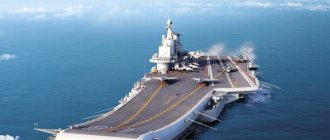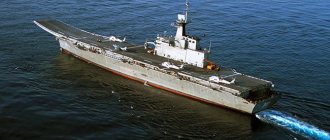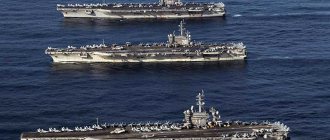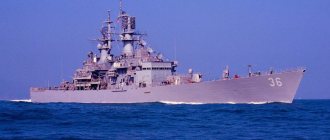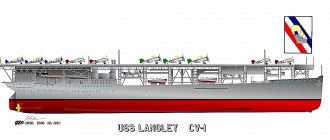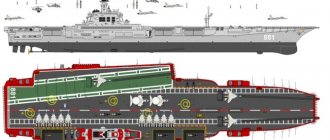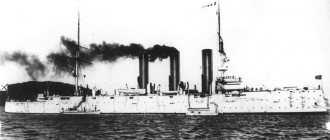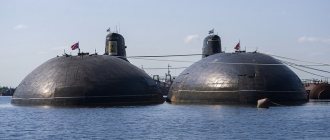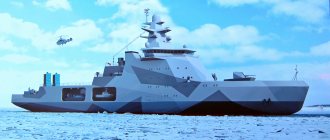The Royal Navy has held a leading position in the world for several centuries. This situation is not accidental, because Great Britain is an island. Most countries developed both ground forces and navies. England, on the other hand, does not have land borders with other states, which means that they placed all their efforts in the military sphere on warships. This strategy has shown excellent results. Along with ensuring the defense of its borders, Britain in the Middle Ages managed to seize many lands around the world, thanks to which it became one of the most powerful powers.
Military development required new developments and combat tactics. Thus, during the Second World War, it became clear that the once powerful battleships were no longer a necessity. The development of aircraft construction prompted design engineers to think about combining ships and aircraft. This is how the first developments of aircraft carriers appeared.
Britain's first aircraft carriers
Along with the USA, England was among the first countries to conduct many tests before creating ships with aircraft on board. Initially, the ships were rebuilt from linear transport ships - the deck surface was increased and strengthened to be able to accommodate weapons on it. In the early years of the 20th century, the Navy commissioned its first seaplane carriers. They housed seaplanes that took off and landed directly from the water surface. And with the help of a special crane, the weapons were lowered into the water and lifted onto the ship. Among the first such ships were HMS Ark Royal and HMS Ben-my-Chree. Both ships took an active part in the First World War. Such developments showed the possibility of conducting combat operations from the air far from home. However, they had a significant drawback. When the sea was very rough, it was not possible to continue combat missions using hydroaviation.
HMS Ark Royal 1914 model
Aircraft carrier HMS Furious
The development of the American fleet required new developments and the Royal Navy. Thus, the first British aircraft carrier Furies was converted from a light battle cruiser. Its deck was increased and was 50 meters. However, this distance was not enough for a safe landing of the plane and it had to be landed on the water. Only one landing was successful - pilot Edwin Harris Dunning equalized the speed of the plane with the speed of the ship, after which the sailors manually pulled the ship on board, as if hanging in the air. 5 days later, a second similar attempt ended tragically: the plane overturned and the pilot died.
HMS Furious 1918
The failure that occurred required further modernization. The deck was increased to 100 meters, and catching nets and arresting devices were installed. During a combat mission on August 19, 1918, seven aircraft that took off from Furies successfully completed their task - they bombed German hangars with airships. At the same time, not a single pilot was able to land the ship on board the ship: 5 drowned during landing, 2 landed at an airfield in Denmark.
Aircraft carrier "Hermes" (HMS Hermes)
Britain was to be the first power in the world to build an aircraft carrier, rather than refit it, as all other countries had done before. She laid the keel of the Hermes ship, but construction lasted seven whole years. By this time, the Japanese had already launched their Hosho.
The Royal Navy underestimated the capabilities of aviation, and therefore equipped the ship with additional weapons, which took up a lot of space and made the ship heavier. As a result, during a strong storm, the aircraft carrier tilted on its side by 4 degrees, which seriously complicated its functionality. By the beginning of World War II, Hermes was considered an obsolete ship, however, it actively served off the coast of West Africa, Iraq, and fought against the Italian fleet in the Red Sea. In 1942 it was sunk by Japanese carrier-based aircraft.
The signing of the Washington Naval Treaty limited all maritime powers in the number of aircraft carriers. For Great Britain, the total displacement should not exceed 135 thousand tons.
Participation in wars and military conflicts
The Second World War can easily be called the war of aircraft carriers. This was a period of active construction of these ships, as well as their active destruction. There were many naval battles that were remembered precisely because of these ships. It is difficult to count how many British aircraft carriers were destroyed during the war. Below we will talk about the most significant ships that made a significant contribution to the history of military affairs.
Ark Royal-class aircraft carrier (HMS Ark Royal)
Before World War II, England had at its disposal 5 aircraft carriers with a total displacement of 115 thousand tons, which means that they had the opportunity to build another heavy ship, the size of which could be 20 thousand tons. Ark Royal included many new solutions in the interior design. This significantly improved the presence of personnel on the ship, and also facilitated the ability to take off and land aircraft.
hms ark royal 1937
During the war, the aircraft carrier took part in the hunt for the most famous German battleship of those times, the Bismarck. The Ark Royal's aircraft damaged the enemy ship's steering compartment, causing it to be sunk by the British battleships. However, already in November 1941, the German submarine U-81 torpedoed the aircraft carrier, and a day later it sank.
Illustrious class aircraft carriers
Combat experience has shown that an aircraft-carrying ship needs powerful armor. Between 1937 and 1940, 4 ships were built with armored hangars located below deck. The number of aircraft was 33 aircraft. The latest Indomiteble was built with thinner armor, allowing the number of weapons to be increased to 45 aircraft.
All aircraft carriers actively participated in combat battles: in the Mediterranean Sea, off the coast of Africa, in the Indian and Pacific oceans. During the war, each of them was seriously damaged and repaired. The final write-off occurred only in the 50-60s.
Implacable class and HMS Unicorn class aircraft carriers
The followers of the Illustriels became the Implacables. They differed from their predecessors in their increased size and heavier aircraft. In 1944, 2 ships were launched, which managed to take part in the battle for Okinawa. In 1954 they were withdrawn from service.
HMS Unicorn 1941
Unicorn, commissioned in 1943, served as England's auxiliary light aircraft carrier. He began serving in the Atlantic, and then was sent to the shores of Southeast Asia. Withdrew from the Navy in 1953.
Colossus class aircraft carriers
Colossus-class aircraft carriers
In the last year of the war, 10 light Colossus-class aircraft carriers entered service with the British Navy. They did not have time to gain combat experience in the battles of World War II, but took part in the military conflict on the Korean Peninsula. The design of the ships was agreed upon back in 1942; it was assumed that they would be a relatively inexpensive alternative to heavy vessels of the Illustriels type. The flight deck was quite spacious - the length was 210 m, while the hull had practically no armor. The crew consisted of 1,300 people, the aviation group included 37 aircraft.
Lonely Hearts Club "Helge Ingstad"
In 2022, one of the most modern ships of the Norwegian Navy, the frigate Helge Ingstad, which cost the country's budget billions of crowns, was scrapped as beyond repair. In November 2022, the Helge Ingstad, returning from exercises, collided with the Greek oil tanker TS Sola in the area of the Norwegian commune of Øygarden.
The crew of the warship was evacuated, and the ship itself sank. The Norwegian Pride was caught in March 2022, costing about NOK 770 million in the rescue operation.
Goodbye, "Helge Ingstad". The sunken NATO frigate was scrapped Read more
But a study of the damage showed that restoring the Helge Ingstad would cost more than building a new ship.
It seems that there is no need for military action today - the military itself copes with the destruction of equipment in peacetime better than any potential enemy.
Aircraft carriers in the post-war period
During the war, Great Britain was quite determined. Therefore, during this time they managed to lay down a large number of ships, including aircraft carriers. Most of them did not manage to be completed within the planned period. This was due to the fact that hostilities ended and the state directed all investments to restore the economic power of the country. This means that funds to complete the production of ships were limited. Nevertheless, most aircraft carriers began to serve in the British Navy.
Majestic class aircraft carriers
A series of 6 light ships that entered service in the post-war period were laid down in 1943. Due to the end of hostilities, the speed of construction was slowed down. As a result, even at the construction stage, 4 vessels were sold to Australia, Canada and India. Another one was never completed. The last aircraft carrier was leased to Canada between 1946 and 1957. All combat units have been decommissioned to date.
Audacious class aircraft carriers
During the war, it was planned to build 4 more heavy aircraft carriers. It was to be a modernized series of Implacable class ships. As a result, construction of only 3 units began; after the victory over Nazi Germany, the production speed decreased. In this regard, in the early 50s, only 2 ships entered service.
"Odeyshes" are considered the most powerful ships in the post-war period. Today they are second only to the Queen Elizabeth aircraft carriers, one of which is already in service with the Royal Navy, and the second is under construction. The length of the vessel was 247 meters, the crew included 2,750 people. There were 60 aircraft on board.
In 1966, due to Britain being part of NATO, a decision was made to optimize the fleet and reduce the number of British ships. In addition, the latest jet aircraft could not be based on outdated ships. Therefore, in the 70s, “Odeishes” was removed from service.
Centaur class aircraft carriers
Another series of light aircraft carriers began to be produced in the last year of the war. Unlike the Majestic class, they could operate new, heavier aircraft. However, the end of the war also changed the construction plans in their case. Of the planned 8 units, construction of 4 was stopped in the fall of 1945. The remainder entered service in the 50s. However, by that time aircraft manufacturing had moved far ahead, and the Centaurus was no longer relevant. Therefore, one ship was decommissioned, and the other three were converted into helicopter carriers.
In the 70s, short/vertical take-off and landing aircraft appeared. Such modifications allowed the last uncommissioned ship, the Hermes, to once again become an aircraft carrier. In 1986 it was sold to India. To date, all copies of the Centaur have been written off.
Invincible class aircraft carriers
In the 1960s, the Royal Navy planned to build its largest heavy aircraft carrier, the Queen Elizabeth. However, a 1966 decision to cut naval spending halted construction. In return, the production of helicopter-carrying cruisers began. A number of improvements during the construction process allowed them to be converted into light aircraft carriers of the Invisible class. They carried 14 weapons - short or vertical take-off and landing aircraft and helicopters. So, in the 80s, the fleet included 3 vessels. All of them took part in the Falklands War between Argentina and Great Britain.
In the early 90s, all ships underwent modernization, as a result of which the hangar was enlarged and the Sea Dart missile system was removed. This made it possible to increase the aircraft capacity to 22 units. To date, all Invincible-class vessels have been decommissioned.
Queen Elizabeth class aircraft carriers
In the 2000s, plans emerged to build new aircraft carriers that would meet all modern needs. It was decided to give this type the name of a ship that was never built in the mid-60s: Queen Elizabeth.
On December 7, 2022, the first of two planned vessels was put into service. This event became very significant for England. This fact can be confirmed by the fact that Queen Elizabeth II herself was present at this event. The second ship is planned to be launched in the summer of 2022, and already in 2022 it should enter service with the Royal Navy. It is noteworthy that the Prince of Wales was present in the dry dock during the official christening ceremony of the second ship. And his wife Camilla became the “godmother” of the aircraft carrier, breaking a bottle of whiskey on the side of the ship. The ships' displacement is 70,600 tons. The deck length is 280 meters. The average number of aircraft will be 40 aircraft, while the maximum load includes up to 50 units of equipment. The British aircraft carriers Queen Elizabeth and Prince of Wales are the largest warships in the history of the Royal Navy. For this, the media gave them an unspoken name - “supercarriers”.
Aviation group includes:
- Multifunctional fifth-generation fighter-bomber F-35B with short take-off and vertical landing. They carry GAU-22/A and GAU-12 cannons, AIM-9X Sidewinder and AIM-120 air-to-air missiles, and a number of air-to-ground missiles.
- Multipurpose helicopters "Merlin" AgustaWestland AW101;
- Wildcat AgustaWestland AW159 helicopters.
For the Prince of Wales under construction, the option of using F-35C fighter-bombers was calculated. This configuration allows for takeoff from the deck of an aircraft carrier using a catapult, and landing on the deck using an aerofinisher. However, in this case, it will be necessary to increase the cost of installing the necessary structures, as a result of which the cost of construction will double. After these calculations, it was decided to leave the deck unchanged and equip the ship with the same F-35B.
Bonhomme Richard: modernize, burn and saw
A week ago, AiF.ru reported that the American universal landing ship-helicopter carrier Bonhomme Richard, seriously damaged by a fire in the summer of 2022, would be cut into scrap metal.
A fire broke out on board the Bonhomme Richard on July 12 while it was at the naval base in San Diego, where the ship was undergoing routine repairs. The epicenter of the fire was the lower cargo deck, where various materials and equipment used during the work were placed during repairs. The fire was so powerful that it bent steel structures and melted tires on vehicles parked on the flight deck. Only the period of open burning on board the ship lasted 27 hours, and it took five days to completely extinguish the fire.
Article on the topic
Write it off and forget it. The US will not restore the burnt helicopter carrier. Shortly before the fire, Bonhomme Richard underwent modernization, during which it was able to receive the latest American F-35 fighter-bombers. The cost of the work was about $250 million.
After the fire was brought under control, the US Navy spent about $10 million clearing debris from the affected decks.
It turned out that 60 percent of the ship's premises required repairs, and its conversion into a hospital ship would cost $1.5 billion. A return to combat would have cost the American budget more than $3 billion.
“After careful consideration, the Navy has decided to decommission USS Bonhomme Richard due to significant damage sustained during a fire in July,” announced Rear Adm. Eric Verhaeghe , commander of the Naval Regional Maintenance Center.
